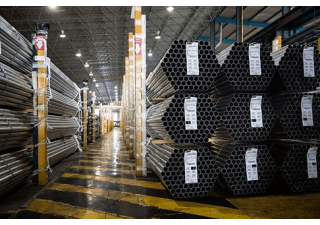
Tubes and pipes
Tubes and pipes are long hollow cylinders made from various materials such as metal, plastic, ceramic, or glass. The choice of material depends on the application and operating conditions of these products. Steel tubes and pipes, for instance, are essential for conveying liquids, gases, and free-flowing substances or for use in mechanical structures.
The difference between tubes and pipes
Although the terms "tubes" and "pipes" are sometimes used interchangeably, they have significant technical differences. Tubes are commonly used in structural applications, such as scaffolding, support systems, handrails, and as protective coverings for electrical or optical cables. Tubes can have various cross-sections, including round, oval, square, rectangular, or triangular. A tube is lighter and stiffer per unit weight than a solid rod, and its strength depends on the wall thickness. Tubes are classified based on their outside diameter (OD) and wall thickness (WT) and are often used where smaller diameters are required. They can be rigid or flexible and may be bent into custom configurations.
Pipes, on the other hand, are primarily used to transport substances such as gases, steam, liquids, slurries, or small solids like pellets and powders. They typically have a round cross-section, which evenly distributes the pressure forces of the substances flowing through. Pipes can be manufactured in large sizes without upper restrictions and are usually rigid. Pipe assemblies are almost always constructed using fittings such as elbows and tees. Pipes are classified according to their inside diameter (ID), nominal diameter, and wall thickness, which are crucial for determining flow rate and capacity.
Applications
Tubes are typically used to protect electrical or optical cables, serve as handrails, or in scaffolding and other support structures. Their lightweight and stiffness per weight unit make them ideal for applications requiring small diameters and custom configurations. Tubes can be either rigid or flexible, depending on the application.
Pipes, which can be manufactured without diameter limitations, are used in various industries, especially where the transportation of fluids or gases is required. The Oil & Gas sector is one of the primary users of pipes due to their ability to withstand high pressures, corrosive environments, and mechanical stresses. Steel pipes, including carbon steel, stainless steel, high-alloy steel, and galvanized steel, are particularly common in upstream operations (Oil Country Tubular Goods - OCTG), midstream operations (for transmission and distribution of oil, gas, and other fluids), and downstream operations (for process piping in refineries).
Other significant industries using pipes include chemicals & petrochemicals, food & beverage, automotive & transportation, water & sewage, infrastructure & construction, mechanical engineering, and power generation & transmission.
Seamless and welded tubes
Another further differentiation is between seamless and welded tubes. Having no longitudinal welds, seamless tubes feature great strength, compactness, and corrosion resistance since they are manufactured from a single piece. One of the best-known production processes is named after the Mannesmann brothers, who in 1885 were the first to engineer a rolling method for the production of seamless steel tubes. What is now known as the Mannesmann process is a combination of two patented inventions: the pierce-rolling and the pilger rolling.
On the one hand, seamless tubes can usually withstand higher pressures and temperatures and don’t require weld integrity tests. They provide better ovality (or roundness) than welded tubes and are generally best suited for critical applications such as the oil & gas industry. On the other hand, welded tubes are typically less expensive than seamless ones. They are available in longer lengths, with thinner walls and tighter tolerances. Welded tubes come into play when no extreme conditions apply, or whenever accurate dimensions and tolerances are required, as in architectural and engineering applications.
Literature
Rolf Kümmerling, Klaus Kraemer: Pipe Manufacture – Seamless Tube and Pipe. Chapter 15. In: R. Winston Revie (ed.): Oil and Gas Pipelines, John Wiley & Sons, Inc., 2015.
Print ISBN: 9781118216712
Online ISBN: 9781119019213
DOI: 10.1002/9781119019213
https://onlinelibrary.wiley.com/doi/book/10.1002/9781119019213
https://doi.org/10.1002/9781119019213.ch15
The information has been compiled by Dipl.-Ing. Konrad Dengler, technical journalist and translator specialized in industrial topics.